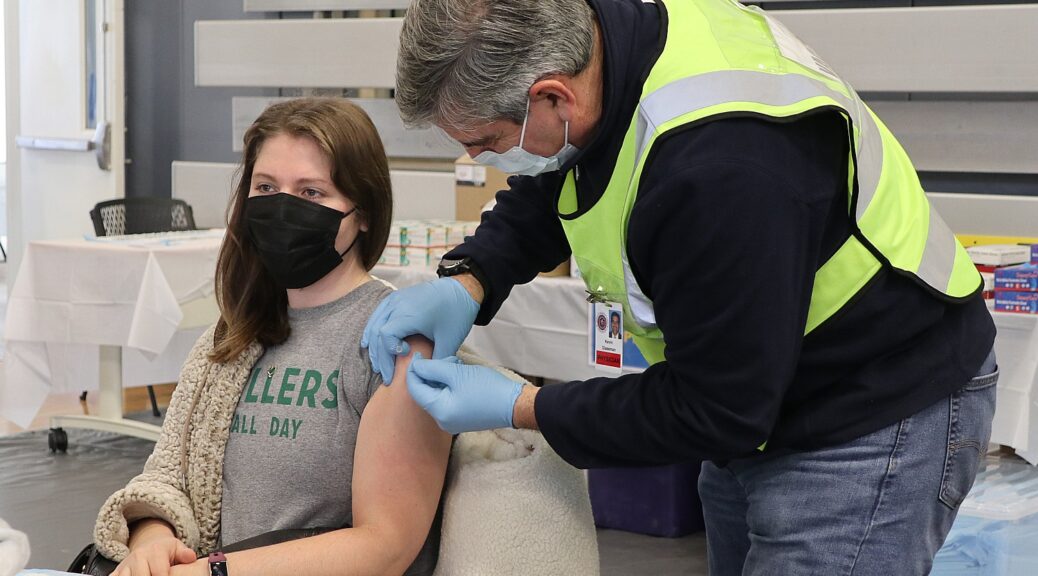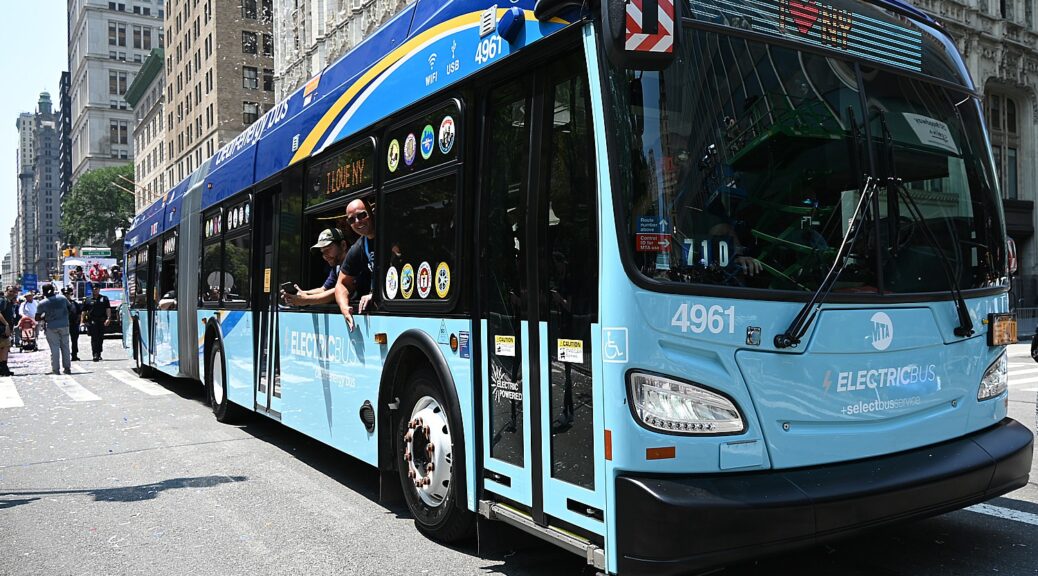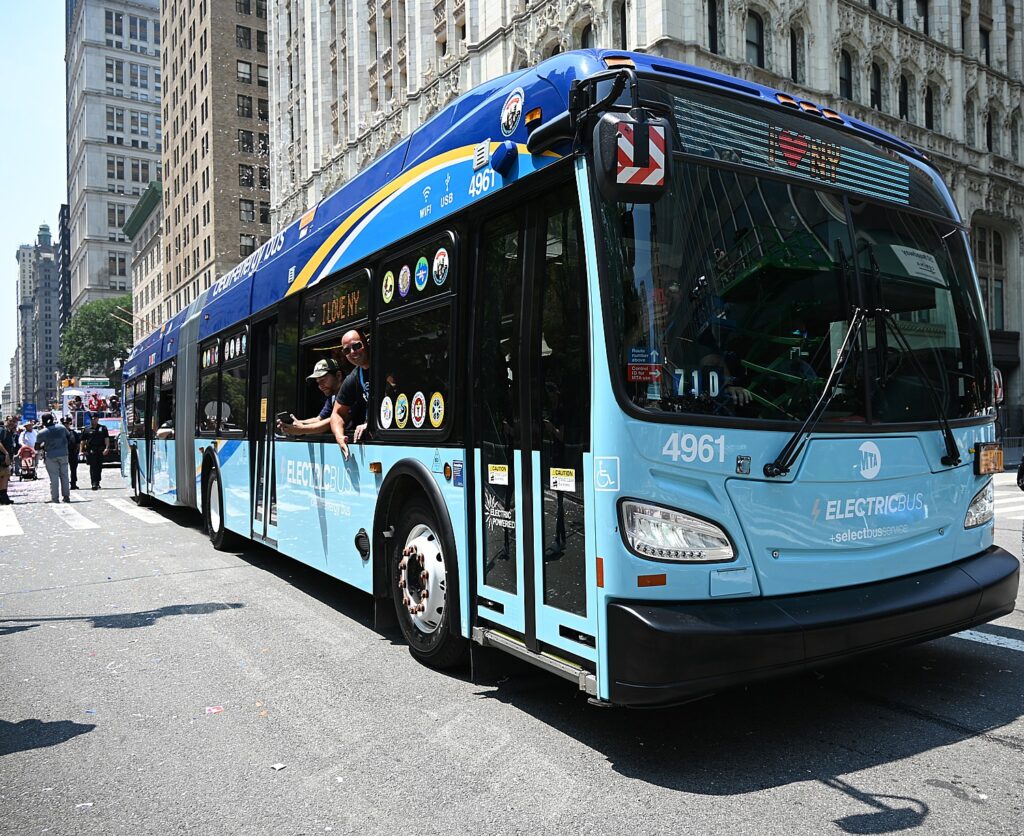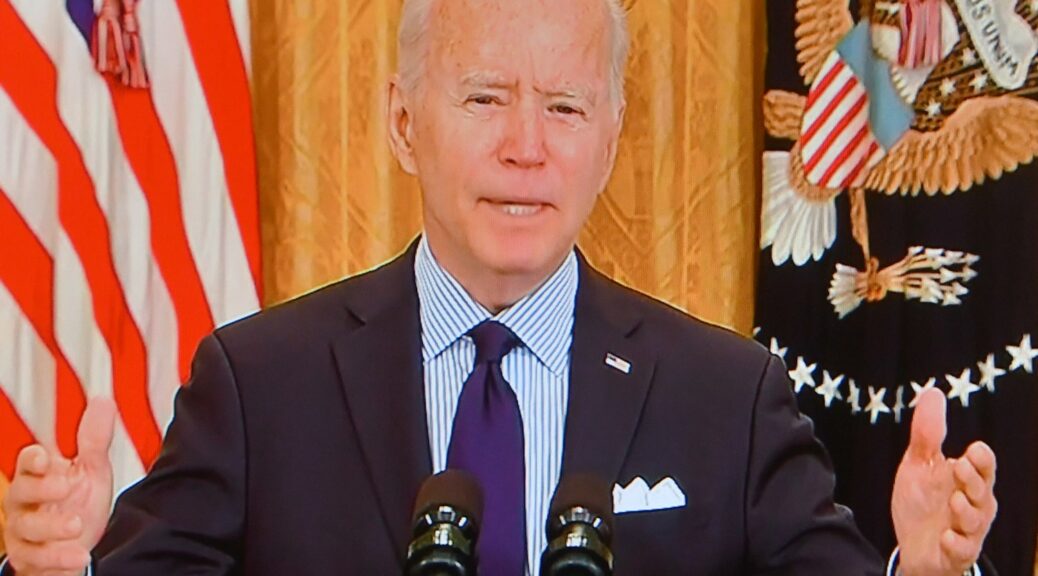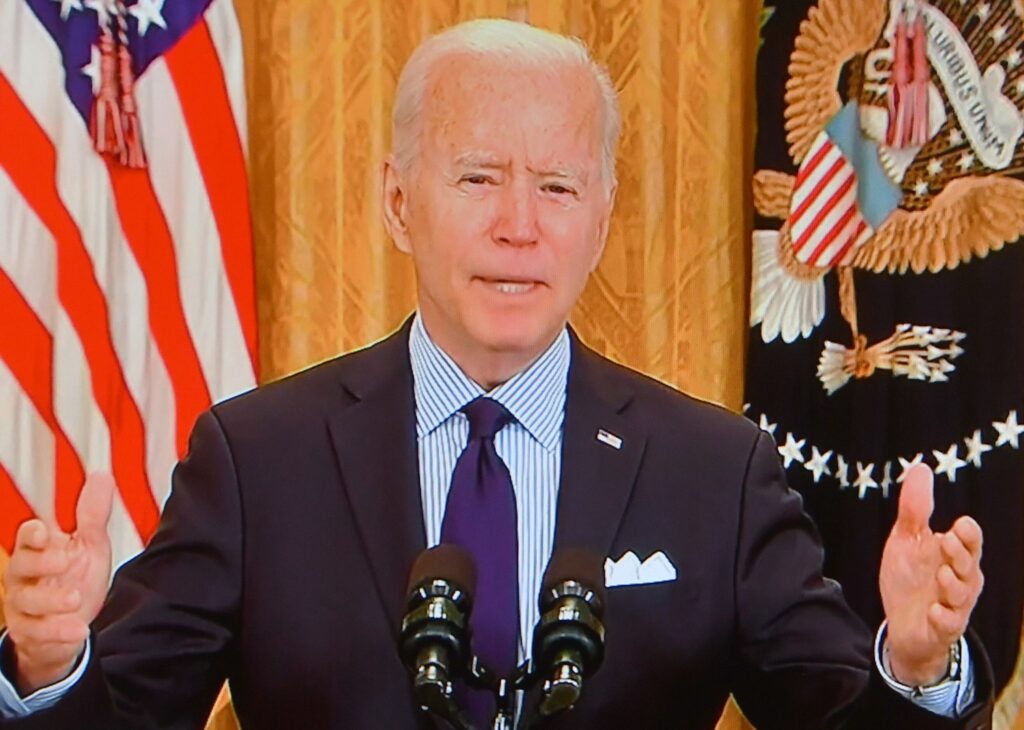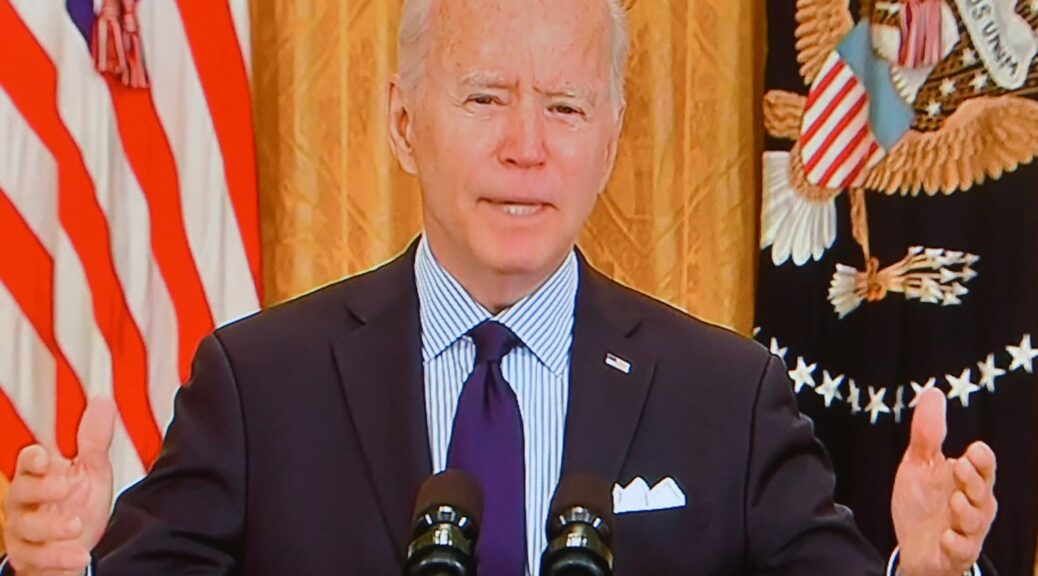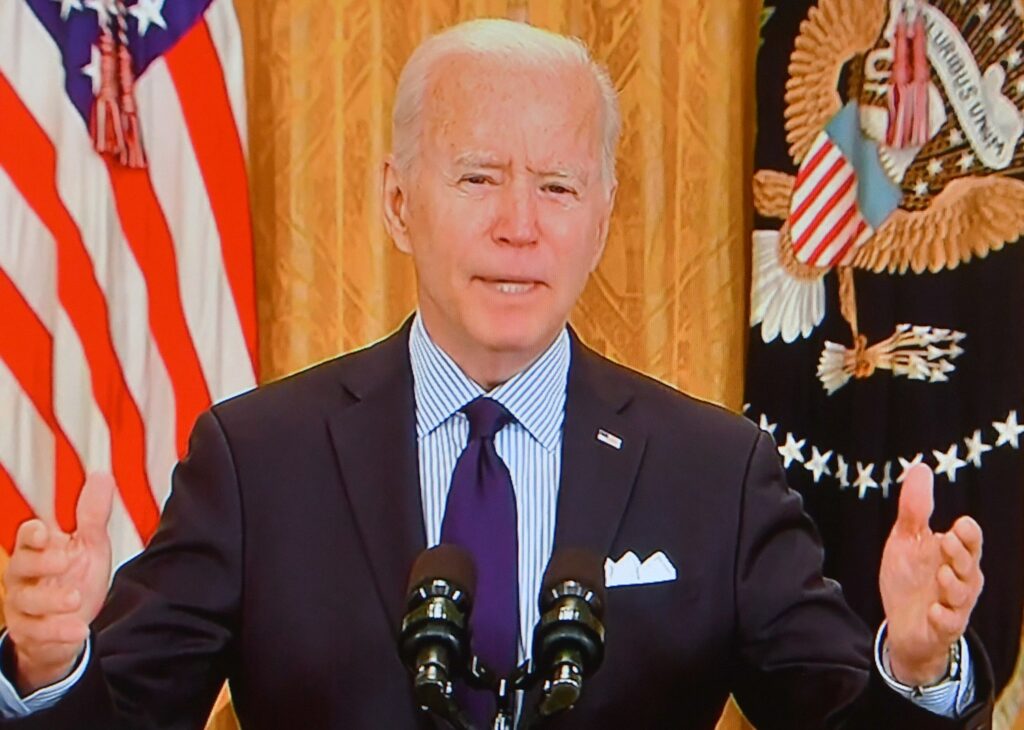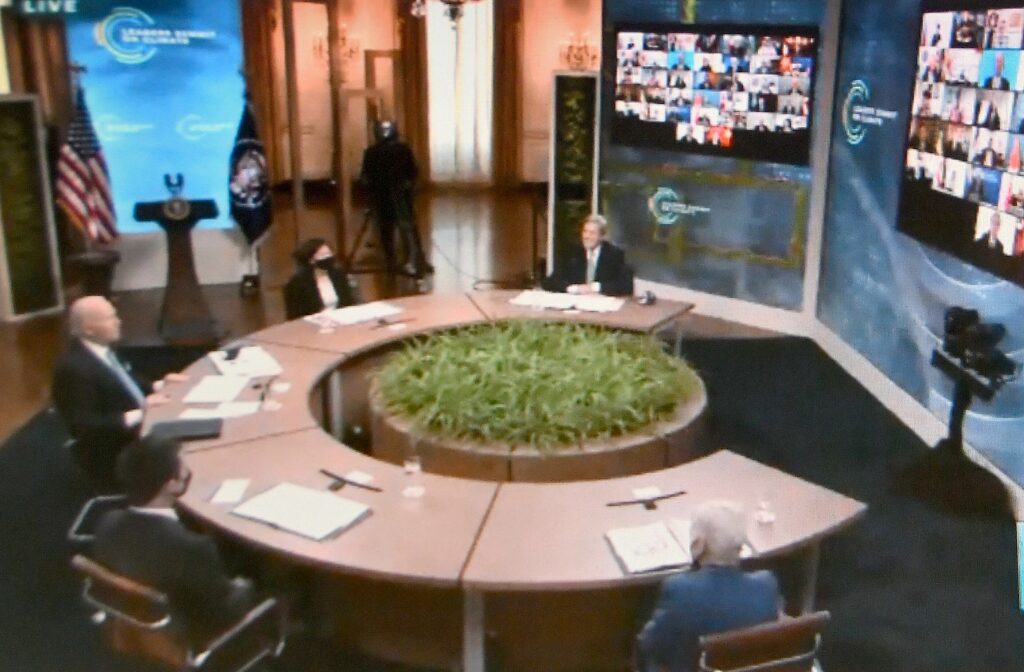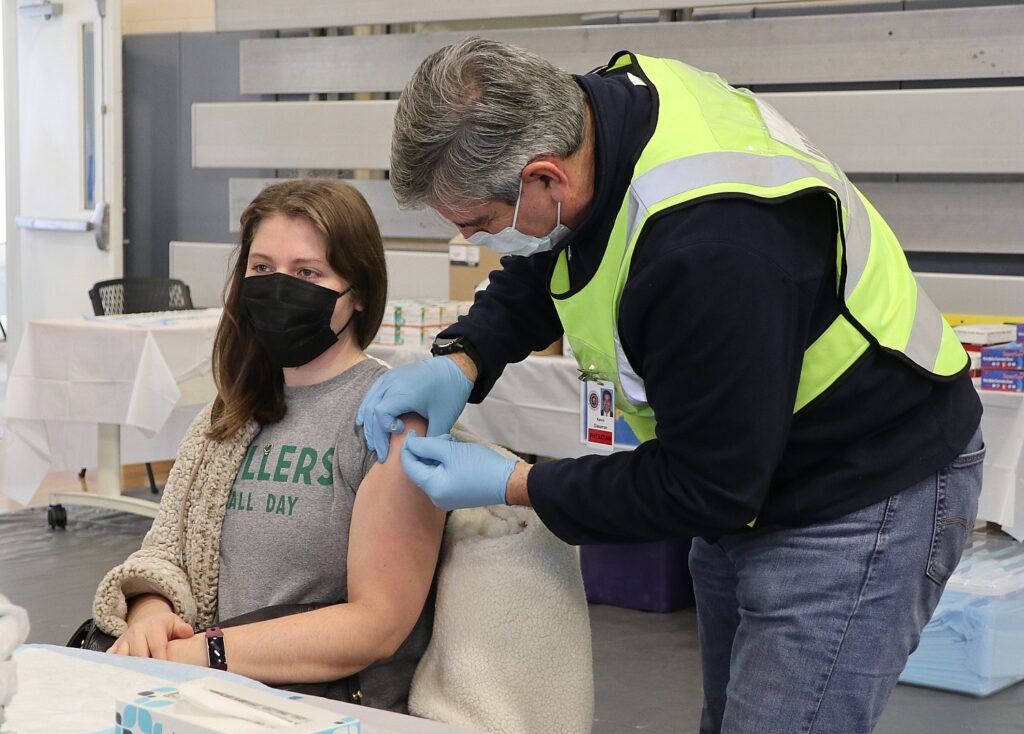
President Joe Biden, declaring that America has lost patience with the 25 percent of Americans – 80 million – who refuse to get vaccinated against COVID-19 in face of a surging Delta variant, put away the carrot and took out the stick, issuing new executive orders that will mandate vaccinations for all federal workers and workers for federal contractors, personnel in hospitals and medical facilities that take Medicare or Medicaid, and requiring corporations with over 100 workers to mandate vaccinations or weekly testing – orders that will cover about two-thirds of all American workers.
“What makes it incredibly more frustrating is that we have the tools to combat COVID-19, and a distinct minority of Americans –supported by a distinct minority of elected officials — are keeping us from turning the corner. These pandemic politics, as I refer to, are making people sick, causing unvaccinated people to die.
“We cannot allow these actions to stand in the way of protecting the large majority of Americans who have done their part and want to get back to life as normal…
“My plan also increases testing, protects our economy, and will make our kids safer in schools. It consists of six broad areas of action and many specific measures in each that — and each of those actions that you can read more about at WhiteHouse.gov.”
Key to the plan is the mandate vaccinations in various instances
“This is not about freedom or personal choice. It’s about protecting yourself and those around you — the people you work with, the people you care about, the people you love.
“My job as President is to protect all Americans.”
To the unvaccinated, the President said, “We’ve been patient, but our patience is wearing thin. And your refusal has cost all of us. So, please, do the right thing. But just don’t take it from me; listen to the voices of unvaccinated Americans who are lying in hospital beds, taking their final breaths, saying, “If only I had gotten vaccinated.” “If only.”
Here’s a highlighted transcript of his speech on September 9, 2021:
THE PRESIDENT: Good evening, my fellow Americans. I want to talk to you about where we are in the battle against COVID-19, the progress we’ve made, and the work we have left to do.
And it starts with understanding this: Even as the Delta variant COVID-19 has been hitting this country hard, we have the tools to combat the virus, if we can come together as a country and use those tools.
If we raise our vaccination rate, protect ourselves and others with masking and expanded testing, and identify people who are infected, we can and we will turn the tide on COVID-19.
It will take a lot of hard work, and it’s going to take some time. Many of us are frustrated with the nearly 80 million Americans who are still not vaccinated, even though the vaccine is safe, effective, and free.
You might be confused about what is true and what is false about COVID-19. So before I outline the new steps to fight COVID-19 that I’m going to be announcing tonight, let me give you some clear information about where we stand.
First, we have made considerable progress in battling COVID-19. When I became President, about 2 million Americans were fully vaccinated. Today, over 175 million Americans have that protection.
Before I took office, we hadn’t ordered enough vaccine for every American. Just weeks in office, we did. The week before I took office, on January 20th of this year, over 25,000 Americans died that week from COVID-19. Last week, that grim weekly toll was down 70 percent.
And in the three months before I took office, our economy was faltering, creating just 50,000 jobs a month. We’re now averaging 700,000 new jobs a month in the past three months.
This progress is real. But while America is in much better shape than it was seven months ago when I took office, I need to tell you a second fact.
We’re in a tough stretch, and it could last for a while. The highly contagious Delta variant that I began to warn America about back in July spread in late summer like it did in other countries before us.
While the vaccines provide strong protections for the vaccinated, we read about, we hear about, and we see the stories of hospitalized people, people on their death beds, among the unvaccinated over these past few weeks.
This is a pandemic of the unvaccinated. And it’s caused by the fact that despite America having an unprecedented and successful vaccination program, despite the fact that for almost five months free vaccines have been available in 80,000 different locations, we still have nearly 80 million Americans who have failed to get the shot.
And to make matters worse, there are elected officials actively working to undermine the fight against COVID-19. Instead of encouraging people to get vaccinated and mask up, they’re ordering mobile morgues for the unvaccinated dying from COVID in their communities. This is totally unacceptable.
Third, if you wonder how all this adds up, here’s the math: The vast majority of Americans are doing the right thing. Nearly three quarters of the eligible have gotten at least one shot, but one quarter has not gotten any. That’s nearly 80 million Americans not vaccinated. And in a country as large as ours, that’s 25 percent minority. That 25 percent can cause a lot of damage — and they are.
The unvaccinated overcrowd our hospitals, are overrunning the emergency rooms and intensive care units, leaving no room for someone with a heart attack, or [pancreatitis], or cancer.
And fourth, I want to emphasize that the vaccines provide very strong protection from severe illness from COVID-19. I know there’s a lot of confusion and misinformation. But the world’s leading scientists confirm that if you are fully vaccinated, your risk of severe illness from COVID-19 is very low.
In fact, based on available data from the summer, only one of out of every 160,000 fully vaccinated Americans was hospitalized for COVID per day.
These are the facts.
So here’s where we stand: The path ahead, even with the Delta variant, is not nearly as bad as last winter. But what makes it incredibly more frustrating is that we have the tools to combat COVID-19, and a distinct minority of Americans –supported by a distinct minority of elected officials — are keeping us from turning the corner. These pandemic politics, as I refer to, are making people sick, causing unvaccinated people to die.
We cannot allow these actions to stand in the way of protecting the large majority of Americans who have done their part and want to get back to life as normal.
As your President, I’m announcing tonight a new plan to require more Americans to be vaccinated, to combat those blocking public health.
My plan also increases testing, protects our economy, and will make our kids safer in schools. It consists of six broad areas of action and many specific measures in each that — and each of those actions that you can read more about at WhiteHouse.gov. WhiteHouse.gov.
The measures — these are going to take time to have full impact. But if we implement them, I believe and the scientists indicate, that in the months ahead we can reduce the number of unvaccinated Americans, decrease hospitalizations and deaths, and allow our children to go to school safely and keep our economy strong by keeping businesses open.
First, we must increase vaccinations among the unvaccinated with new vaccination requirements. Of the nearly 80 million eligible Americans who have not gotten vaccinated, many said they were waiting for approval from the Food and Drug Administration — the FDA. Well, last month, the FDA granted that approval.
So, the time for waiting is over. This summer, we made progress through the combination of vaccine requirements and incentives, as well as the FDA approval. Four million more people got their first shot in August than they did in July.
But we need to do more. This is not about freedom or personal choice. It’s about protecting yourself and those around you — the people you work with, the people you care about, the people you love.
My job as President is to protect all Americans.
So, tonight, I’m announcing that the Department of Labor is developing an emergency rule to require all employers with 100 or more employees, that together employ over 80 million workers, to ensure their workforces are fully vaccinated or show a negative test at least once a week.
Some of the biggest companies are already requiring this: United Airlines, Disney, Tysons Food, and even Fox News.
The bottom line: We’re going to protect vaccinated workers from unvaccinated co-workers. We’re going to reduce the spread of COVID-19 by increasing the share of the workforce that is vaccinated in businesses all across America.
My plan will extend the vaccination requirements that I previously issued in the healthcare field. Already, I’ve announced, we’ll be requiring vaccinations that all nursing home workers who treat patients on Medicare and Medicaid, because I have that federal authority.
Tonight, I’m using that same authority to expand that to cover those who work in hospitals, home healthcare facilities, or other medical facilities –- a total of 17 million healthcare workers.
If you’re seeking care at a health facility, you should be able to know that the people treating you are vaccinated. Simple. Straightforward. Period.
Next, I will sign an executive order that will now require all executive branch federal employees to be vaccinated — all. And I’ve signed another executive order that will require federal contractors to do the same.
If you want to work with the federal government and do business with us, get vaccinated. If you want to do business with the federal government, vaccinate your workforce.
And tonight, I’m removing one of the last remaining obstacles that make it difficult for you to get vaccinated.
The Department of Labor will require employers with 100 or more workers to give those workers paid time off to get vaccinated. No one should lose pay in order to get vaccinated or take a loved one to get vaccinated.
Today, in total, the vaccine requirements in my plan will affect about 100 million Americans –- two thirds of all workers.
And for other sectors, I issue this appeal: To those of you running large entertainment venues — from sports arenas to concert venues to movie theaters — please require folks to get vaccinated or show a negative test as a condition of entry.
And to the nation’s family physicians, pediatricians, GPs — general practitioners –- you’re the most trusted medical voice to your patients. You may be the one person who can get someone to change their mind about being vaccinated.
Tonight, I’m asking each of you to reach out to your unvaccinated patients over the next two weeks and make a personal appeal to them to get the shot. America needs your personal involvement in this critical effort.
And my message to unvaccinated Americans is this: What more is there to wait for? What more do you need to see? We’ve made vaccinations free, safe, and convenient.
The vaccine has FDA approval. Over 200 million Americans have gotten at least one shot.
We’ve been patient, but our patience is wearing thin. And your refusal has cost all of us. So, please, do the right thing. But just don’t take it from me; listen to the voices of unvaccinated Americans who are lying in hospital beds, taking their final breaths, saying, “If only I had gotten vaccinated.” “If only.”
It’s a tragedy. Please don’t let it become yours.
The second piece of my plan is continuing to protect the vaccinated.
For the vast majority of you who have gotten vaccinated, I understand your anger at those who haven’t gotten vaccinated. I understand the anxiety about getting a “breakthrough” case.
But as the science makes clear, if you’re fully vaccinated, you’re highly protected from severe illness, even if you get COVID-19.
In fact, recent data indicates there is only one confirmed positive case per 5,000 fully vaccinated Americans per day.
You’re as safe as possible, and we’re doing everything we can to keep it that way — keep it that way, keep you safe.
That’s where boosters come in — the shots that give you even more protection than after your second shot.
Now, I know there’s been some confusion about boosters. So, let me be clear: Last month, our top government doctors announced an initial plan for booster shots for vaccinated Americans. They believe that a booster is likely to provide the highest level of protection yet.
Of course, the decision of which booster shots to give, when to start them, and who will give them, will be left completely to the scientists at the FDA and the Centers for Disease Control.
But while we wait, we’ve done our part. We’ve bought enough boosters — enough booster shots — and the distribution system is ready to administer them.
As soon as they are authorized, those eligible will be able to get a booster right away in tens of thousands of sites across the country for most Americans, at your nearby drug store, and for free.
The third piece of my plan is keeping — and maybe the most important — is keeping our children safe and our schools open. For any parent, it doesn’t matter how low the risk of any illness or accident is when it comes to your child or grandchild. Trust me, I know.
So, let me speak to you directly. Let me speak to you directly to help ease some of your worries.
It comes down to two separate categories: children ages 12 and older who are eligible for a vaccine now, and children ages 11 and under who are not are yet eligible.
The safest thing for your child 12 and older is to get them vaccinated. They get vaccinated for a lot of things. That’s it. Get them vaccinated.
As with adults, almost all the serious COVID-19 cases we’re seeing among adolescents are in unvaccinated 12- to 17-year-olds — an age group that lags behind in vaccination rates.
So, parents, please get your teenager vaccinated.
What about children under the age of 12 who can’t get vaccinated yet? Well, the best way for a parent to protect their child under the age of 12 starts at home. Every parent, every teen sibling, every caregiver around them should be vaccinated.
Children have four times higher chance of getting hospitalized if they live in a state with low vaccination rates rather than the states with high vaccination rates.
Now, if you’re a parent of a young child, you’re wondering when will the vaccine be available for them. I strongly support an independent scientific review for vaccine uses for children under 12. We can’t take shortcuts with that scientific work.
But I’ve made it clear I will do everything within my power to support the FDA with any resource it needs to continue to do this as safely and as quickly as possible, and our nation’s top doctors are committed to keeping the public at large updated on the process so parents can plan.
Now to the schools. We know that if schools follow the science and implement the safety measures — like testing, masking, adequate ventilation systems that we provided the money for, social distancing, and vaccinations — then children can be safe from COVID-19 in schools.
Today, about 90 percent of school staff and teachers are vaccinated. We should get that to 100 percent. My administration has already required teachers at the schools run by the Defense Department — because I have the authority as President in the federal system — the Defense Department and the Interior Department — to get vaccinated. That’s authority I possess.
Tonight, I’m announcing that we’ll require all of nearly 300,000 educators in the federal paid program, Head Start program, must be vaccinated as well to protect your youngest –– our youngest — most precious Americans and give parents the comfort.
And tonight, I’m calling on all governors to require vaccination for all teachers and staff. Some already have done so, but we need more to step up.
Vaccination requirements in schools are nothing new. They work. They’re overwhelmingly supported by educators and their unions. And to all school officials trying to do the right thing by our children: I’ll always be on your side.
Let me be blunt. My plan also takes on elected officials and states that are undermining you and these lifesaving actions. Right now, local school officials are trying to keep children safe in a pandemic while their governor picks a fight with them and even threatens their salaries or their jobs. Talk about bullying in schools. If they’ll not help — if these governors won’t help us beat the pandemic, I’ll use my power as President to get them out of the way.
The Department of Education has already begun to take legal action against states undermining protection that local school officials have ordered. Any teacher or school official whose pay is withheld for doing the right thing, we will have that pay restored by the federal government 100 percent. I promise you I will have your back.
The fourth piece of my plan is increasing testing and masking. From the start, America has failed to do enough COVID-19 testing. In order to better detect and control the Delta variant, I’m taking steps tonight to make testing more available, more affordable, and more convenient. I’ll use the Defense Production Act to increase production of rapid tests, including those that you can use at home.
While that production is ramping up, my administration has worked with top retailers, like Walmart, Amazon, and Kroger’s, and tonight we’re announcing that, no later than next week, each of these outlets will start to sell at-home rapid test kits at cost for the next three months. This is an immediate price reduction for at-home test kits for up to 35 percent reduction.
We’ll also expand free testing at 10,000 pharmacies around the country. And we’ll commit — we’re committing $2 billion to purchase nearly 300 million rapid tests for distribution to community health centers, food banks, schools, so that every American, no matter their income, can access free and convenient tests. This is important to everyone, particularly for a parent or a child — with a child not old enough to be vaccinated. You’ll be able to test them at home and test those around them.
In addition to testing, we know masking helps stop the spread of COVID-19. That’s why when I came into office, I required masks for all federal buildings and on federal lands, on airlines, and other modes of transportation.
Today — tonight, I’m announcing that the Transportation Safety Administration — the TSA — will double the fines on travelers that refuse to mask. If you break the rules, be prepared to pay.
And, by the way, show some respect. The anger you see on television toward flight attendants and others doing their job is wrong; it’s ugly.
The fifth piece of my plan is protecting our economic recovery. Because of our vaccination program and the American Rescue Plan, which we passed early in my administration, we’ve had record job creation for a new administration, economic growth unmatched in 40 years. We cannot let unvaccinated do this progress — undo it, turn it back.
So tonight, I’m announcing additional steps to strengthen our economic recovery. We’ll be expanding COVID-19 Economic Injury Disaster Loan programs. That’s a program that’s going to allow small businesses to borrow up to $2 million from the current $500,000 to keep going if COVID-19 impacts on their sales.
These low-interest, long-term loans require no repayment for two years and be can used to hire and retain workers, purchase inventory, or even pay down higher cost debt racked up since the pandemic began. I’ll also be taking additional steps to help small businesses stay afloat during the pandemic.
Sixth, we’re going to continue to improve the care of those who do get COVID-19. In early July, I announced the deployment of surge response teams. These are teams comprised of experts from the Department of Health and Human Services, the CDC, the Defense Department, and the Federal Emergency Management Agency — FEMA — to areas in the country that need help to stem the spread of COVID-19.
Since then, the federal government has deployed nearly 1,000 staff, including doctors, nurses, paramedics, into 18 states. Today, I’m announcing that the Defense Department will double the number of military health teams that they’ll deploy to help their fellow Americans in hospitals around the country.
Additionally, we’re increasing the availability of new medicines recommended by real doctors, not conspiracy theorists. The monoclonal antibody treatments have been shown to reduce the risk of hospitalization by up to 70 percent for unvaccinated people at risk of developing sefe- — severe disease.
We’ve already distributed 1.4 million courses of these treatments to save lives and reduce the strain on hospitals. Tonight, I’m announcing we will increase the average pace of shipment across the country of free monoclonal antibody treatments by another 50 percent.
Before I close, let me say this: Communities of color are disproportionately impacted by this virus. And as we continue to battle COVID-19, we will ensure that equity continues to be at the center of our response. We’ll ensure that everyone is reached. My first responsibility as President is to protect the American people and make sure we have enough vaccine for every American, including enough boosters for every American who’s approved to get one.
We also know this virus transcends borders. That’s why, even as we execute this plan at home, we need to continue fighting the virus overseas, continue to be the arsenal of vaccines.
We’re proud to have donated nearly 140 million vaccines over 90 countries, more than all other countries combined, including Europe, China, and Russia combined. That’s American leadership on a global stage, and that’s just the beginning.
We’ve also now started to ship another 500 million COVID vaccines — Pfizer vaccines — purchased to donate to 100 lower-income countries in need of vaccines. And I’ll be announcing additional steps to help the rest of the world later this month.
As I recently released the key parts of my pandemic preparedness plan so that America isn’t caught flat-footed when a new pandemic comes again — and it will — next month, I’m also going to release the plan in greater detail.
So let me close with this: We have made so much progress during the past seven months of this pandemic. The recent increases in vaccinations in August already are having an impact in some states where case counts are dropping in recent days. Even so, we remain at a critical moment, a critical time. We have the tools. Now we just have to finish the job with truth, with science, with confidence, and together as one nation.
Look, we’re the United States of America. There’s nothing — not a single thing — we’re unable to do if we do it together. So let’s stay together.
God bless you all and all those who continue to serve on the frontlines of this pandemic. And may God protect our troops.
Get vaccinated.

